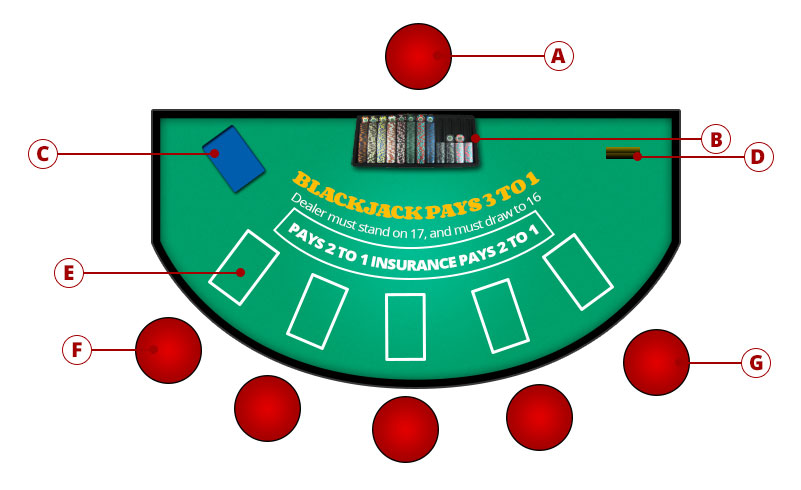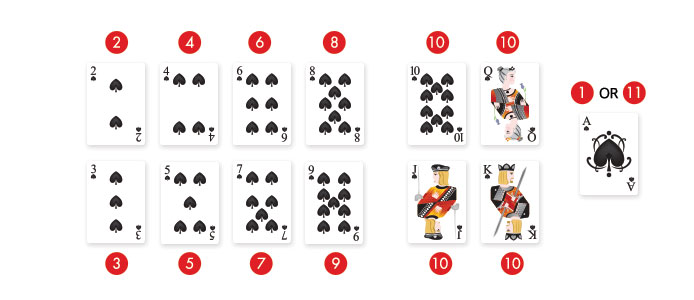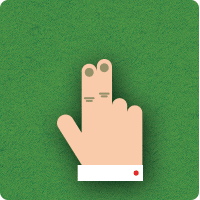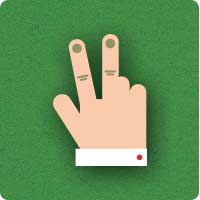How to Play Blackjack
A popular game with casino aficionados and newcomers alike, blackjack continues to captivate fans around the world as it contains all the elements to make it a classic. It has both simplicity and strategy, as players try to beat the dealer without going over 21.
Blackjack Table Layout

- ADealer
- BHouse Chips
- CDiscard Tray
- DMinimum Bet Sign
- EBetting Square
- FThird Base
- GFirst Base
Where to Play Blackjack
Seek out casinos which offer the most player-friendly rules so that your blackjack strategies will be most effective. Look out for the following combinations of rules:
- A single deck game
- Surrender, both early and late
- Double down allowed on any two cards
- Double down allowed after splitting pairs
- Multiple pair splitting allowed, plus re-splitting aces
- Dealer stands on a soft 17
- Deep deck penetration
Basic Rules
player in blackjack plays against the dealer and is initially given two cards. Picture cards (jack, queen and king) are worth 10, number cards are worth their face value and aces can count as either one or 11. There are different variations of the game, but typically between one and eight standard 52-card decks will be used, and players can calculate the total value of their first two cards before deciding how to proceed.
One option is to hit (ask for another card) to try and take you closer to 21. The other choice is not to ask for another card, which is known as standing or sticking. If you have been dealt a hand totalling 21 from your two cards (an ace and a card worth 10), then you have a blackjack and cannot lose.
If you ask for a third card and your total goes over 21, you have gone bust and have automatically lost. In most cases, there is no limit to the amount of times you can hit in blackjack as long as your total remains under 21.
The objective is to beat the dealer, whose first card will be face up so you have an idea of what you are betting against. There will be a rule on when the dealer must stand, and in many games the number will be 17. If you have a higher score than the dealer without going bust then you are a winner, or if the dealer goes bust and you don’t. A winning blackjack hand pays 3:2 and any other winning hand pays 1:1. If the player and the dealer finish with the same score, it is known as a push and your bet is returned to you.
Players also have a number of other options. You can decide to double your bet after receiving two cards and be dealt one more card only. Alternatively, if you have a pair, you can split it into two separate hands. You can also surrender in some casinos, allowing you to give up your hand and get half your bet back if you don’t think you’re going to win.
Blackjack Card Values

Etiquette
- Know the rules and learn the hit-stand signals for the blackjack game you’re playing.
- Use one hand when touching your cards. Casinos are very strict when it comes to the condition of their cards and players have been known to try and bend certain cards very slightly, for example aces, to gain an unfair advantage.
- After placing your wager, don't touch your bet until you get paid.
- Behave in a civilised manner. You will be asked to leave if you use abusive language or confrontational behaviour.
- Do not ask the dealer about their hole card (their second card which players can’t see). Dealers won't risk their job over your wager. There's nothing wrong with asking for advice, but not after the dealer knows their hole card.
- Be polite to the dealer but let them do their job. Once the hand is over, the dealer has a routine on the pick-up and turning your cards over in an effort to help only slows them down.
Blackjack Hand Signals

Scraping the cards gently against the felt indicates to the dealer that you wish to hit.
To signal that you wish to stand, slide your cards under your bet without lifting your chips.
If you want to double your bet after the dealer gives you your first two cards, place more chips next to your original wager. Hold up one finger.

To indicate that you want to split, place more chips next to your initial bet and hold up your middle and index fingers in a ‘V’ sign.
Strategy
It is important to focus on the dealer when playing blackjack, not the performance or strategy of other players at the table. Keep your emotions in check, never increase your bet when you are losing and avoid drinking when you are playing in order to keep a level head. Set limits on how much you are prepared to bet and stick to your policy of when to hit, stand or double a bet.
blackjack charts have been designed to help players memorise the best way to play any given hand. As with any game that involves luck, this is not an exact science, but studying charts such as the one below can give you an idea of what to do depending on what cards you have and what the dealer has.
| Dealer's Best Card: | 2 | 3 | 4 | 5 | 6 | 7 | 8 | 9 | 10 | A |
|---|---|---|---|---|---|---|---|---|---|---|
| Your Cards Total: | ||||||||||
| 5 to 8 | H | H | H | H | H | H | H | H | H | H |
| 9 | H | D | D | D | D | H | H | H | H | H |
| 10 | D | D | D | D | D | D | D | D | H | H |
| 11 | D | D | D | D | D | D | D | D | D | D |
| 12 | H | H | S | S | S | H | H | H | H | H |
| 13 | S | S | S | S | S | H | H | H | H | H |
| 14 | S | S | S | S | S | H | H | H | H | H |
| 15 | S | S | S | S | S | H | H | H | H | H |
| 16 | S | S | S | S | S | H | H | H | H | H |
| 17 to 21 | S | S | S | S | S | S | S | S | S | S |
| Ace/2 to Ace/6 | H | H | H | H | H | H | H | H | H | H |
| Ace/7 | S | S | S | S | S | S | S | H | H | H |
| Ace/8 to Ace/10 | S | S | S | S | S | S | S | S | S | S |
H = Hit D = Double S = Stand
Like all casino games, the house will win more often than the punter, but one of the reasons that blackjack is so popular is that players have more control over the outcome of their experience than in many other games.
One key hint is to remember that the aim of the game is not to land on 21, or as close to it as possible, but to beat the dealer. While blackjack charts are helpful, they can be difficult to memorise and their use at the tables is not looked on favourably. However, there are several other good tips.
- Treat aces as 11s when you you also have a 7 or greater; otherwise treat them as 1s.
- Never stand on 11 or less.
- Stand on 17, apart from when it is a soft 17 (when you have an ace and can hit without being in danger of going bust)
- Double down on 11 every time and on ten unless the dealer’s card has a value of ten.
- Split aces and eights, but never tens.
It can also be a good tactic to surrender from time to time. It may seem counter-intuitive to even give away a chance of winning, but dropping out can save you a bit of money. It is recommended that you surrender on 15 when the dealer hits on soft 17 and their shown card is ten or a face card. It might also be an idea to surrender on 15 or 16 when the dealer stands on soft 17 and their card is ten.
Some players think that copying the dealer is the way to go but this is a strategy best avoided, as it means you could miss out on wonderful opportunities to split or double. Another theory best consigned to oblivion is that you should never bust. In an ideal world you would never exceed 21, but the only way to ensure this happens is to never hit a hard 12 or more, which really means that you would regularly need the dealer to bust.
Card Counting
Counting cards is a strategy employed by some players to reduce the risk of losing. Players will keep track of the high and low cards dealt out to calculate which cards are left and therefore work out what they are likely to receive next. It is not illegal but does give players an advantage and therefore casinos will keep a keen lookout for anyone they think is counting cards, as many are allowed to ask such players to leave.
Those casinos which are not allowed to bar card counters impose tougher rules, such as having multi-deck games and limiting deck penetration to keep the skilled counter at bay. For those who enjoy playing blackjack online, card counting is impossible as the virtual deck is shuffled every time and this cannot be seen.
Insurance/Side Bets
When the dealer’s face-up card is an ace, blackjack players will be offered insurance. This is an opportunity to put out half of your bet as an insurance against the dealer having a blackjack. When the dealer does have a blackjack the player's original bet loses and the insurance bet is paid two to one, meaning that you will neither win nor lose on that hand. If the dealer does not have a blackjack you have a chance of winning your original wager but have lost your insurance bet. The insurance bet offers poor value and is widely discouraged.
Insurance is a form of side bet, and many casinos will offer other types of side bet on various outcomes. Among the most common side bets, apart from an insurance bet, is ‘Perfect Pairs’, when players have the chance to bet that their first two cards will be either a perfect pair (for example 2x ace of spades), a coloured pair (for example an ace of spades and an ace of clubs) or a mixed pair (for example an ace of spades and an ace of hearts). The odds of success are very low but the appeal of such side bets is that they offer bigger rewards, and casinos will typically promote their side bets because the house edge is much higher than for traditional blackjack.
Important Terms:
Visit the Casino Glossary for more terms which you might find in blackjack or other casino games.
